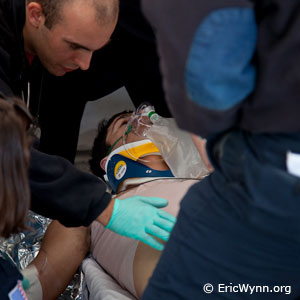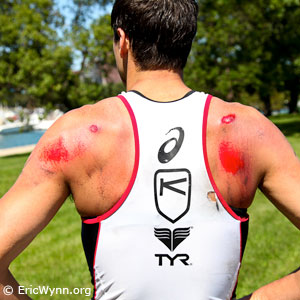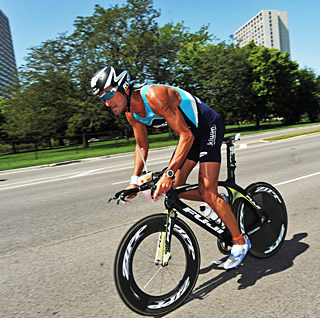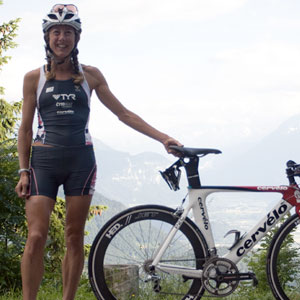The Potts Crash

It didn’t look as bad as the multiple bike crash in the Vuelta de Espana that recently took down a dozen or more riders broke bones and ended the race or the season for several cyclists. But when an age group rider drifted into the path of pro triathlete Andy Potts at the Chicago Triathlon last Sunday, the incident pointed out just how thin a line it is between a crash that a tough athlete can shake off and potential disaster.
Potts led out of the swim and had just been passed by rival and good friend Matt Reed about 8 miles into the bike leg when an age group triathlete drifted into the recommended fast lane used by the pros. Just after the turnaround on Lakeshore Drive, the leaders were pushed along by a big tailwind, flying along at an estimated 35 to 37 miles per hour.
The way it worked, the slower age group athletes were riding closest to the concrete barrier that separates the north- and southbound lanes. That would normally be called the passing lane for automobile traffic. The pro triathletes rode in the middle lane and passed to the right of the age groupers. The passing lane used by the pros was separated by orange traffic cones from bumper-to-bumper, stop-and-go local automobile traffic in the far right lane.
“Matt Reed had just passed me and was about 12 meters ahead of me and Matt Chrabot, who was about 3 meters behind and 3 meters to my side – legal under the stagger rule used for the pro wave in this race,” said Potts. “Although I cannot speak for the age group athlete, I would guess that when Matt went by an instant before I did, at such a high rate of speed, that probably startled him. When we came up on him, I would guess that he was going maybe 15 miles per hour – if that – and we were traveling more than twice that fast.”

In an interview later in the week, Potts said that his wife Lisa asked him if there was anything he might have done differently to avoid the crash. “The answer is no,” said Potts. “My only option theoretically might have been to try to veer outside the cones. But that would have put me into the line of cars and would have been an even worse choice. But we were traveling so fast I could not have reacted that quickly.” Pitts added that an observation by Matt Chrabot cited in some post-race stories was inaccurate. “I know that things happened so fast it was hard for anybody involved to make an accurate observation,” said Potts. “But looking back, I recall all the details in what seems like slow motion. I was not looking down for an instant before the crash. I was riding in the aero position with my head up.”
A release written by Potts’ agent Charlie Foltz stated that after impact, Potts slid “150-200 feet on grooved pavement. His helmet protected him from head injury, but Potts did suffer road rash and received stitches in his right elbow from doctors who compared the crash to that of a motorcycle collision.”
Immediately after the crash, Potts tried to pick up his bike and finish the race, but his Kuota bike frame was beyond repair. At that point, things got scary. Taken to the medical tent for observation, the release stated that Potts’ “vital signs dropped and his resting heart rate fell to 20 beats per minute, at which point he lost consciousness. EMTs responded immediately and Potts was transported to Northwestern Hospital where he had a CAT scan and X-Rays. Based on the evaluations, doctors concluded there were no broken bones or internal injuries and he was released from the hospital that evening.”
While initial reports indicated that Potts was not seriously hurt, everyone took a step back when the full details of losing consciousness came out. “Things were more serious than I originally thought,” recalled Potts. “It was pretty scary for both me and Lisa a bit there about one hour after the accident. My body is recovering slowly and I'm taking all the necessary precautions regarding when to get back into training.” After returning to Colorado Springs Monday for further medical evaluation, Potts put off any training until doctors clear him to return. In particular, the deep cuts in his elbow, besides cutting down on normal range of motion, preclude a return to the pool until the skin has healed and threat of infection is over.
When asked if his injuries would take him out of his highly anticipated return to the Ironman World Championship in Kona in October – or significantly affect his training and readiness — Potts said “I can't see how this would not affect it. However, while I will do everything necessary to eliminate all long term effects, I remain optimistic.”
Safety issues

On a day in which young cycling phenom Andrew Yoder got hit hard in the head during the swim and pulled out early on the bike when he felt to ill to continue and Julie Dibens fell over in a low speed collision with another age grouper, pros had some suggestions for increasing safety in an important race that now combines the world’s fastest and some of the slowest triathletes on the same bike course at the same time.
“There was no lead vehicle to warn the age groupers we were coming,” said Matt Chrabot, who finished second to Matt Reed. “A lot of the age groupers were riding on the right hand side of the bike lanes and obviously didn’t know we were coming. This is a problem that could easily be fixed with a few modifications – just have a lead vehicle to honk the horn.”
Women’s winner Sarah Haskins said, “I think the pros should go first” rather than take off last and work their way through the final age group waves. She added that the big pack of highly competitive pro men also presented additional problems. Referring to Julie Dibens collision with an age grouper that came immediately after a slow U-turn made among a few age group riders, Haskins said “I go very slow through the turns and I didn’t have a problem today. I gave everyone a lot of room when I pass. Also, the guys are much faster than the women. When I came up to someone I had time to yell ‘on your right!’ Plus there wasn't anyone near me. The guys were bunched together and were trying to focus on staying far enough apart to maintain a legal stagger. If you’re in a group, it makes it so much harder.”
Haskins added that some crashes are inevitable. “Crashing is part of the game,” said Haskins, the 2008 ITU World Championship silver medalist and the 5th ranked women in the International Triathlon Union 2009 World Championship Series. “I crashed at Hamburg this year in the rain. It’s not as easy to crash when it’s dry, but it happens.”
Best wishes

By far the predominant emotion was sympathy and good wishes for a speedy recovery for the universally admired and well-liked Potts.
“I feel really bad for Andy,” said Matt Reed. “I love racing against Andy because he’s such a great competitor and a great sportsman. I really hope he is all right and will be back soon.”
“I feel really bad,” said Matt Chrabot. “I did some training with Andy last summer and he is a very generous guy. I really look up to Andy – he’s put the sport in a great light.”
After Potts’ great 7th place last year in his debut at Kona, plus his wins at half Ironman distance races at Wildflower and Timberman 70.3, and his third win at Escape from Alcatraz, anticipation was high to see what he could do if he took a more thorough preparation than he had time for last year. This year, Potts did everything right up to this point. But as every pro with ambitions at Kona knows, the last six weeks are critical.
Stay tuned.
All images are courtesy of Eric Wynn. More at EricWynn.org



